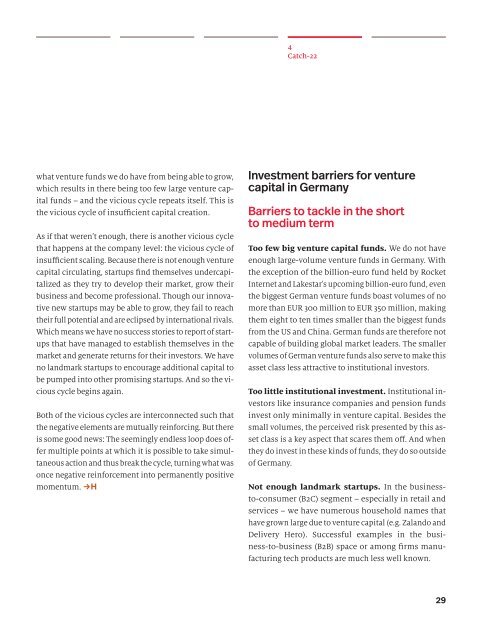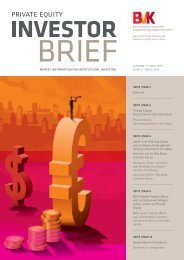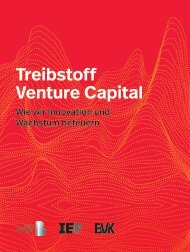Treibstoff Venture Capital (Fuel Venture Capital): Fueling innovation and economic growth
There is a lack of venture capital (VC) in Germany, especially in the growth phase of newly founded companies. As a result, the necessary capital to establish successful companies from innovative business models is lacking. In view of the international competition between technology locations, this lack weakens the innovative power of the European economy and hinders sustainable growth. The new study "Fuel Venture Capital: How we fuel innovation and growth" by Roland Berger, the Internet Economy Foundation (IE.F) and the Bundesverband Deutscher Kapitalbeteiligungsgesellschaften e.V. (Association of German Private Equity Firms). (BVK) analyses existing investment barriers to venture capital and explains how these can be overcome.
There is a lack of venture capital (VC) in Germany, especially in the growth phase of newly founded companies. As a result, the necessary capital to establish successful companies from innovative business models is lacking. In view of the international competition between technology locations, this lack weakens the innovative power of the European economy and hinders sustainable growth. The new study "Fuel Venture Capital: How we fuel innovation and growth" by Roland Berger, the Internet Economy Foundation (IE.F) and the Bundesverband Deutscher Kapitalbeteiligungsgesellschaften e.V. (Association of German Private Equity Firms). (BVK) analyses existing investment barriers to venture capital and explains how these can be overcome.
Create successful ePaper yourself
Turn your PDF publications into a flip-book with our unique Google optimized e-Paper software.
4<br />
Catch-22<br />
what venture funds we do have from being able to grow,<br />
which results in there being too few large venture capital<br />
funds – <strong>and</strong> the vicious cycle repeats itself. This is<br />
the vicious cycle of insufficient capital creation.<br />
As if that weren’t enough, there is another vicious cycle<br />
that happens at the company level: the vicious cycle of<br />
insufficient scaling. Because there is not enough venture<br />
capital circulating, startups find themselves undercapitalized<br />
as they try to develop their market, grow their<br />
business <strong>and</strong> become professional. Though our innovative<br />
new startups may be able to grow, they fail to reach<br />
their full potential <strong>and</strong> are eclipsed by international rivals.<br />
Which means we have no success stories to report of startups<br />
that have managed to establish themselves in the<br />
market <strong>and</strong> generate returns for their investors. We have<br />
no l<strong>and</strong>mark startups to encourage additional capital to<br />
be pumped into other promising startups. And so the vicious<br />
cycle begins again.<br />
Both of the vicious cycles are interconnected such that<br />
the negative elements are mutually reinforcing. But there<br />
is some good news: The seemingly endless loop does offer<br />
multiple points at which it is possible to take simultaneous<br />
action <strong>and</strong> thus break the cycle, turning what was<br />
once negative reinforcement into permanently positive<br />
momentum. →H<br />
Investment barriers for venture<br />
capital in Germany<br />
Barriers to tackle in the short<br />
to medium term<br />
Too few big venture capital funds. We do not have<br />
enough large-volume venture funds in Germany. With<br />
the exception of the billion-euro fund held by Rocket<br />
Internet <strong>and</strong> Lakestar's upcoming billion-euro fund, even<br />
the biggest German venture funds boast volumes of no<br />
more than EUR 300 million to EUR 350 million, making<br />
them eight to ten times smaller than the biggest funds<br />
from the US <strong>and</strong> China. German funds are therefore not<br />
capable of building global market leaders. The smaller<br />
volumes of German venture funds also serve to make this<br />
asset class less attractive to institutional investors.<br />
Too little institutional investment. Institutional investors<br />
like insurance companies <strong>and</strong> pension funds<br />
invest only minimally in venture capital. Besides the<br />
small volumes, the perceived risk presented by this asset<br />
class is a key aspect that scares them off. And when<br />
they do invest in these kinds of funds, they do so outside<br />
of Germany.<br />
Not enough l<strong>and</strong>mark startups. In the businessto-consumer<br />
(B2C) segment – especially in retail <strong>and</strong><br />
services – we have numerous household names that<br />
have grown large due to venture capital (e.g. Zal<strong>and</strong>o <strong>and</strong><br />
Delivery Hero). Successful examples in the business-to-business<br />
(B2B) space or among firms manufacturing<br />
tech products are much less well known.<br />
29

















